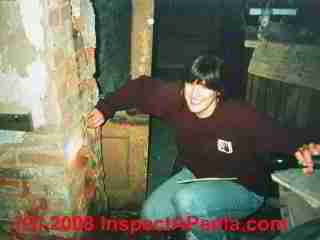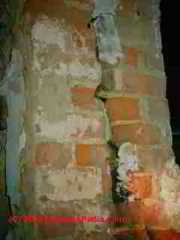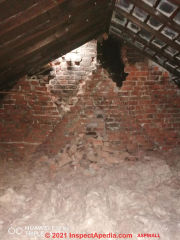 What to Do About Splitting or Collapsing Brick Chimneys
What to Do About Splitting or Collapsing Brick Chimneys
- POST a QUESTION or COMMENT about splits and gaps in brick chimneys: evaluation, diagnosis, repair or replacement
Collapsing chimney diagnosis, evaluation & repair guide.
Beginning here we discuss how to spot very serious and unsafe brick chimneys indoors; Chimney splits or cracks may threaten a dangerous collapse, fire hazard or a fatal carbon monoxide CO hazard;
Advice for immediate safety actions needed when a chimney is in immediate danger of collapse, fire, and flue gas leakage.
This article describes a collapsing brick chimney and gives simple advice for immediate life-safety measures to be taken in the building.
InspectAPedia tolerates no conflicts of interest. We have no relationship with advertisers, products, or services discussed at this website.
- Daniel Friedman, Publisher/Editor/Author - See WHO ARE WE?
Split Openings in Brick Chimneys & Chimney Collapse Risk
 Watch out: Chimneys with splitting or movement such as that shown in our photographs below should not be patched, repaired, or re-lined. Nor can this chimney be used safely, not even for a moment.
Watch out: Chimneys with splitting or movement such as that shown in our photographs below should not be patched, repaired, or re-lined. Nor can this chimney be used safely, not even for a moment.
The chimney structure, material, and probably its footings are or were inadequate and unsafe. A chimney tear-down and replacement are in order. In some cases by converting a heating system to a direct-vent flue it may be possible to cut the costs of this repair in half.
Photo: a seriously-split and completely unsafe brick chimney, detail from the page-top photo.
[Click to enlarge any image]
Inspect chimneys carefully throughout the building for evidence of holes, cracks, or damage, but pay special attention to brick chimneys that may split and actually break apart in their lowest sections.
We suspect that the combination of the heavy weight of a very tall brick masonry flue combined with the use of soft bricks and construction that used only a single brick width to form the thickness of the chimney caused the severe splitting of the brick masonry flue shown in these two basement photos.
This damage pattern is more likely to be found on single-wythe thick brick chimneys than on chimneys built with multiple thickness of bricks forming the chimney wall.
This chimney was in use and was very dangerous. The hazards of a split brick chimney include at least these:
- Risk of sudden catastrophic collapse
of the whole chimney, injuring occupants and damaging the building.
See details at CHIMNEY COLLAPSE RISKS, REPAIRS
- Potentially fatal carbon monoxide
gas leakage in the building - A fire
risk from sparks that could fly out of the chimney split - Inadequate chimney draft
(due to the split which admits excess air into the chimney base) which in turn causes improper and unsafe operating of heating equipment venting through this chimney, including the production of carbon monoxide.
...
Reader Comments, Questions & Answers About The Article Above
Below you will find questions and answers previously posted on this page at its page bottom reader comment box.
Reader Q&A - also see RECOMMENDED ARTICLES & FAQs
On 2021-09-23 by inspectapedia.com.moderator (mod) - Council House Brick Chimney Collapse Hazards
 @Wesley Aspinall,
@Wesley Aspinall,
Watch out: your photo shows a dangerous brick masonry collapse that can mean
1. risk of falling building materials injuring building occupants or worse, killing someone.
2. risk of fatal carbon monoxide poisoning or a building fire if the damage includes a building chimney
It is possible that your building is unsafe to occupy.
Be sure that the building has working fire and smoke and CO detectors.
Turn OFF any heating equipment that is venting into the chimney that is damaged/collapsing/cracked, etc.
Immediate inspection by a fire or masonry expert or chimney expert is needed.
If you are in the U.K.,
Fire safety law is enforced by Fire Safety Enforcement Officers from the local Fire and Rescue Service. They have the right and legal authority to enter any workplace at any reasonable hour, without giving notice, though notice may be given where the inspector thinks it is appropriate.
The RP should establish if the EO has the authorisation to conduct an inspection before allowing him on the premises.
The EO will then conduct an inspection to check out the workplace, the work activities, your management of fire safety, and audit your fire risk assessment to ensure you are complying with fire safety law.
The EO may offer guidance or advice to help you. He/she may also talk to employees or their representatives, take photographs, serve notices, and take action if there is a risk to fire safety that needs to be dealt with immediately. - in "What to Expect if a Fire Safety Inspector Calls", Fire Safety Advice Centre, retrieved 2021/09/23 original source: https://www.firesafe.org.uk/what-to-expect-if-a-fire-safety-inspector-calls/ Safelincs Ltd.,
33 West Street, Alford, LN13 9FX U.K..
Website excerpt: The Fire Safety Advice Centre provides free fire safety and fire prevention advice in the United Kingdom. Its resource library offers fire safety information for homes and businesses.
The principal fire safety legislation in England and Wales is The Regulatory Reform (Fire Safety) Order 2005 and there are other fire safety legislations that cover specific situations. In addition British Standards, Codes of Practice and other documents offer guidance.
Depending on where you live you can ask for a fire safety check from local officials. For example,
In London call 0800 028 4428 or [for less-immediate concerns]
email smokealarms@london-fire.gov.uk.
On 2021-09-23 by Wesley Aspinall
Really appreciate any input having phone the council several times about minor changes now we are having drastic changes don't know who to call or how bad it is.
...
Continue reading at CHIMNEY CRACK DETECTION & DIAGNOSIS or select a topic from the closely-related articles below, or see the complete ARTICLE INDEX.
Or see these
Recommended Articles
- ABANDONED CHIMNEYS
- BRICK CHIMNEY CRACKS & COLLAPSE
- CHIMNEY COLLAPSE RISKS, REPAIRS
- CHIMNEY CRACK DETECTION & DIAGNOSIS
- CHIMNEY DAMAGE by LEAKS & FROST
- CHIMNEY FLUE INSPECTION CAMERA
- CHIMNEY HEIGHT & CLEARANCE CODE for details about the required height of a chimney above the building roof.
- CHIMNEY INSPECTION DIAGNOSIS REPAIR - home
- CHIMNEY LEANING, SEPARATION, MOVEMENT
- CHIMNEY REPAIR METHODS - home
- CONCRETE BLOCK CHIMNEY CRACKS
- CURVED BRICK CHIMNEYS, SULPHATION
- EARTHQUAKE CHIMNEY COLLAPSE DANGERS
- FIREPLACE DAMAGE & UNSAFE HEARTHS
- SOIL PROPERTIES & BUILDING FAILURES
Suggested citation for this web page
BRICK CHIMNEY CRACKS & COLLAPSE at InspectApedia.com - online encyclopedia of building & environmental inspection, testing, diagnosis, repair, & problem prevention advice.
Or see this
INDEX to RELATED ARTICLES: ARTICLE INDEX to CHIMNEYS & FLUES
Or use the SEARCH BOX found below to Ask a Question or Search InspectApedia
Ask a Question or Search InspectApedia
Questions & answers or comments about splits and gaps in brick chimneys: evaluation, diagnosis, repair or replacement .
Try the search box just below, or if you prefer, post a question or comment in the Comments box below and we will respond promptly.
Search the InspectApedia website
Note: appearance of your Comment below may be delayed: if your comment contains an image, photograph, web link, or text that looks to the software as if it might be a web link, your posting will appear after it has been approved by a moderator. Apologies for the delay.
Only one image can be added per comment but you can post as many comments, and therefore images, as you like.
You will not receive a notification when a response to your question has been posted.
Please bookmark this page to make it easy for you to check back for our response.
IF above you see "Comment Form is loading comments..." then COMMENT BOX - countable.ca / bawkbox.com IS NOT WORKING.
In any case you are welcome to send an email directly to us at InspectApedia.com at editor@inspectApedia.com
We'll reply to you directly. Please help us help you by noting, in your email, the URL of the InspectApedia page where you wanted to comment.
Citations & References
In addition to any citations in the article above, a full list is available on request.
- Mark Cramer Inspection Services Mark Cramer, Tampa Florida, Mr. Cramer is a past president of ASHI, the American Society of Home Inspectors and is a Florida home inspector and home inspection educator. Mr. Cramer serves on the ASHI Home Inspection Standards. Contact Mark Cramer at: 727-595-4211 mark@BestTampaInspector.com
- Thanks to Luke Barnes for suggesting that we add text regarding the hazards of shared chimney flues. USMA - Sept. 2008.
- Arlene Puentes [Website: www.octoberhome.com ] , an ASHI member and a licensed home inspector in Kingston, NY, and has served on ASHI national committees as well as HVASHI Chapter President. Ms. Puentes can be contacted at ap@octoberhome.com
- NFPA 211 - Standards for Chimneys & Fireplaces, NFPA 211: Standard for Chimneys, Fireplaces, Vents, and Solid Fuel-Burning Appliances, 2006 Edition (older editions and standards are found at the same bookstore)
- NFPA #211-3.1 1988 - Specific to chimneys, fireplaces, vents and solid fuel burning appliances.
- NFPA # 54-7.1 1992 - Specific to venting of equipment with fan-assisted combustion systems.
- GAMA - Gas Appliance Manufacturers' Association has prepared venting tables for Category I draft hood equipped central furnaces as well as fan-assisted combustion system central furnaces.
- National Fuel Gas Code, an American National Standard, 4th ed. 1988 (newer edition is available) Secretariats, American Gas Association (AGA), 1515 Wilson Blvd., Arlington VA22209, and National Fire Protection Association (NFPA), Batterymarch Park, Quincy MA 02269. ANSI Z223.1-1988 - NFPA 54-1988. WARNING: be sure to check clearances and other safety guidelines in the latest edition of these standards.
- Fire Inspector Guidebook, A Correlation of Fire Safety Requirements Contained in the 1987 BOCA National Codes, (newer edition available), Building Officials and Code Administrators International, Inc. (BOCA), Country Club HIlls, IL 60478 312-799-2300 4th ed. Note: this document is reissued every four years. Be sure to obtain the latest edition.
- Uniform Mechanical Code - UMC 1991, Sec 913 (a.) Masonry Chimneys, refers to Chapters 23, 29, and 37 of the Building Code.
- New York 1984 Uniform Fire Prevention and Building Code, Article 10, Heating, Ventilating, and Air Conditioning Requirements
- New York 1979 Uniform Fire Prevention & Building Code, The "requirement" for 8" of solid masonry OR for use of a flue liner was listed in the One and Two Family Dwelling Code for New York, in 1979, in Chapter 9, Chimneys and Fireplaces, New York 1979 Building and Fire Prevention Code:
- "Top Ten Chimney (and related) Problems Encountered by One Chimney Sweep," Hudson Valley ASHI education seminar, 3 January 2000, contributed by Bob Hansen, ASHI
- Our recommended books about building & mechanical systems design, inspection, problem diagnosis, and repair, and about indoor environment and IAQ testing, diagnosis, and cleanup are at the InspectAPedia Bookstore. Also see our Book Reviews - InspectAPedia.
- Ceramic Roofware, Hans Van Lemmen, Shire Library, 2008, ISBN-13: 978-0747805694 - Brick chimneys, chimney-pots and roof and ridge tiles have been a feature of the roofs of a wide range of buildings since the late Middle Ages. In the first instance this ceramic roofware was functional - to make the roof weatherproof and to provide an outlet for smoke - but it could also be very decorative. The practical and ornamental aspects of ceramic roofware can still be seen throughout Britain, particularly on buildings of the Victorian and Edwardian periods. Not only do these often have ornate chimneys and roof tiles but they may also feature ornamental sculptures or highly decorative gable ends. This book charts the history of ceramic roofware from the Middle Ages to the present day, highlighting both practical and decorative applications, and giving information about manufacturers and on the styles and techniques of production and decoration. Hans van Lemmen is an established author on the history of tiles and has lectured on the subject in Britain and elsewhere. He is founder member and presently publications editor of the British Tiles and Architectural Ceramics Society.
- Chimney Inspection Checklist, Carson Dunlop, Associates, Toronto, Ontario
- Chimney & Stack Inspection Guidelines, American Society of Civil Engineers, 2003 - These guidelines address the inspection of chimneys and stacks. Each guideline assists owners in determining what level of inspection is appropriate to a particular chimney and provides common criteria so that all parties involved have a clear understanding of the scope of the inspection and the end product required. Each chimney or stack is a unique structure, subject to both aggressive operating and natural environments, and degradation over time. Such degradation may be managed via a prudent inspection program followed by maintenance work on any equipment or structure determined to be in need of attention. Sample inspection report specifications, sample field inspection data forms, and an example of a developed plan of a concrete chimney are included in the guidelines. This book provides a valuable guidance tool for chimney and stack inspections and also offers a set of references for these particular inspections.
- Fireplaces, a Practical Design Guide, Jane Gitlin
- Fireplaces, Friend or Foe, Robert D. Mayo
- NFPA 211 - Standards for Chimneys & Fireplaces, NFPA 211: Standard for Chimneys, Fireplaces, Vents, and Solid Fuel-Burning Appliances, 2006 Edition (older editions and standards are found at the same bookstore)
- Principles of Home Inspection: Chimneys & Wood Heating, in (Principles of Home Inspection), Carson Dunlop, Associates, Toronto, Ontario
- NFPA 211 - 3-1.10 - Relining guide for chimneys
- NFPA 211 - 3-2 - Construction of Masonry Chimneys
- NFPA 211 - 3-3 - Termination Height for chimneys
- NFPA 211 - 3-4 - Clearance from Combustible Material
- NFPA 54 - 7-1 - Venting of Equipment into chimneys
- Brick Institute of America - Flashing Chimneys
Brick Institute of America - Proper Chimney Crowns
Brick Institute of America - Moisture Resistance of Brick - American Gas Association - New Vent Sizing Tables
- Chimney Safety Institute of America - Chimney Fires: Causes, Effects, Evaluation
- National Chimney Sweep Guild - Yellow Pages of Suppliers
- In addition to citations & references found in this article, see the research citations given at the end of the related articles found at our suggested
CONTINUE READING or RECOMMENDED ARTICLES.
- Carson, Dunlop & Associates Ltd., 120 Carlton Street Suite 407, Toronto ON M5A 4K2. Tel: (416) 964-9415 1-800-268-7070 Email: info@carsondunlop.com. Alan Carson is a past president of ASHI, the American Society of Home Inspectors.
Thanks to Alan Carson and Bob Dunlop, for permission for InspectAPedia to use text excerpts from The HOME REFERENCE BOOK - the Encyclopedia of Homes and to use illustrations from The ILLUSTRATED HOME .
Carson Dunlop Associates provides extensive home inspection education and report writing material. In gratitude we provide links to tsome Carson Dunlop Associates products and services.

